Menus
- What you must remember
- Themore
- Theless
- Prices
- Make yourYamaha YZF-R1 1000 2020
- Opinion
- Replaces
- Performances
- The technical aspect
- Competitors
- Gallery
- Related articles
The R1 needed to polish itself, to evolve, to go the distance against the monsters of its clan. Since the arrival of the Ducati Panigale V4-R, the small world of WSBK has been in a state of high pressure. With the Yamaha performing again, the time has come to give a boost with a lot of small changes for 2020.
Especially on the technical side. The list goes on and the new features will delight electronics fans. Design side, the R1 moves very little. Always very inspired by the M1 of MotoGP, it is satisfied to retouch somewhat its facies and its sides at the level of the tank. The eye must be trained to perceive the differences. But the efficiency is there: Aerodynamic efficiency is increased by more than 5%, which translates into greater performance at high speeds. New LED headlights and redesigned LED position lights further underline the look and character of this 2020 model. This fairing incorporates a new aluminum air duct located at the rear for increased rigidity. The lower part of the fairing that covers the exhaust system is now made of titanium.
Under the surface, on the other hand, the detail is much more verbose.
200 horsepower. This has been the norm for some time in this category. The crossplane engine is still developing them, without any increase since the previous generation, but this does not mean that the engineers have stood idly by, they have improved the performance of the 4-cylinder at high revs thanks to the adoption of new rocker arms at Pawl latches and new cam profiles that provide optimized valve lift, as well as more stable valve openings and closings at high rpm. This ensures smoother and more efficient engine operation..
Increased combustion efficiency
One of the most important changes to this model is the new intake design: a redesigned cylinder head and a set of repositioned injectors optimize engine performance. Intake valves are moved closer to the combustion chambers to reduce intake volume for better combustion stability and efficiency. New Bosch injectors are now positioned above the 45mm diameter injection bodies, rather than below. These new 10-hole injectors deliver fuel more directly to the combustion chambers, and also offer a wider 21.5 degree spray angle to improve combustion efficiency..
Other improvements should be noted: redesigned exhaust system with 4 catalysts, including a pair located in front of the exhaust chamber and another pair at the rear. The silencer and the thermal protectors of the engine are equipped with additional elements to limit the sound volume.
The new R1, however, pays its tribe. She weighs 2 kilos.
Increased engine efficiency
For greater engine operating efficiency and lower power losses, the crankshaft lubrication system has been revised and now has larger crankshaft bearings. In addition, the oil pump uses a 10% more compact rotor. In the crankcase, resized oil ducts optimize pressure, while the pistons benefit from the redesigned nozzles for their cooling.
The second speed sprocket is now wider for greater transmission efficiency, and the final transmission chain is reinforced by the use of thicker links. In addition, in order to improve cooling at the exhaust ports, a new arrangement of the cylinder head coolant duct has been determined..
APSG Ride-by-Wire acceleration system for better control
Yamaha’s electronic throttle control system (YCC-T) that controls the intake valves is retained for 2020. For better acceleration feel and reduced weight, the R1 benefits from a new system. APSG (throttle grip with position sensor). A magnet / sensor device transmits its signals to the YCC-T. In order to maintain an intuitive feel at the throttle grip, the new APSG unit is fitted with a specific spring, slide and gear. Grip rotation and acceleration remain natural and smooth for better control and greater rider / machine interaction.
Optimized suspensions for a better feeling
The R1’s fork, a 43mm diameter Kayaba with 120mm travel, is considered the best in its class, and its components have been tweaked to improve rider feel. The new damping valves are stacked, and this feature, combined with less spring calibration and a revised fork oil level, gives the operator more precise information about the running surface. The result is a more direct and natural control of the machine..
A modified steering damper, as well as new rear damper settings, further improve the performance of the 2020 R1 chassis.
Braking and handling
The 320mm dual front disc with monobloc calipers is renowned for its power and the formidable braking feeling it offers. In 2020, pads with a new friction material increase braking power. The latest Bridgestone Battlax RS11 tires deliver exceptional traction and precise feel, allowing the rider to push their limits even further.
State-of-the-art electronic control technology
The R1 was the first production motorcycle to adopt a form of artificial intelligence via a 6-axis inertial unit (IMU). The R1 has true 3D measurement of movement. The IMU (Inertial Measuring Unit) evaluates movements in three dimensions (forward, sideways, and up and down), plus a gyroscopic measurement in three dimensions (pitch, roll and yaw). By constantly analyzing this data taken 125 times per second, the IMU defines the position of the R1 and its behavior – including bank angle, slip and attitude changes..
For 2020, the hypersport benefits from two new technologies that further increase its potential on the track.
New Brake Control (BC) System – Cornering ABS
The new brake control (BC) system allows the rider to select one of two ABS modes (BC1 and BC2), in line with his personal preferences and driving conditions.
BC1 mode offers constant ABS adjustment, while BC2 mode adjusts according to the lean angle and grip of the machine. In BC2 mode, ABS sensitivity increases as the lean angle increases, providing more confidence and control in curves.
Front and rear wheel speed data as well as inertial unit (IMU) information, such as lean angle and slip, are transmitted to the hydraulic unit and the ABS electronic control unit. that perform calculations in real time. This information then allows the brake control to prevent the wheels from locking by modulating the hydraulic pressure in the front and rear brake circuits..
New Engine Brake Management System (EBM)
Another new electronic technology in the R1 is its Engine Brake Management (EBM) system, which gives the rider the ability to choose from three levels of braking force (high – medium – low) to suit a wide variety of driving situations and personal preferences. Using data from various sensors including gear engaged, engine speed, throttle grip position, and throttle position, the ECU adjusts throttle opening, ignition timing and the injection volume to control the level of engine braking. EBM1 offers highest engine braking force, EBM3 lowest.
Modified start-up assistance (LCS)
The R1’s Starting Assist (LCS) is proving even more effective for 2020. LCS1 mode has been changed to activate at 9,000 rpm with a 41-degree throttle opening..
Taking into account the BC and EBM, as well as the modification of the Departure Control System (LCS), the R1 2020 has a total of 7 electronic driver assistance systems and control functions. The pilot is more relaxed and can adapt the machine exactly to his requirements. Each electronic system integrates seamlessly with other systems to provide a natural and intuitive feel.
Complete TFT dashboard
The TFT-type LCD display now features the new brake control (BC) and engine brake management (EBM) functions.
2020 Yamaha R1: new features
– Optimized fairing
– Aerodynamic efficiency increased by more than 5%
– Optimized suspension for better feedback from the ground
– New 2-mode ABS (BC) system for cornering braking
– New 3-mode engine brake management (EBM) system
– Optimized departure control system (LCS)
– New APSG Ride-by-Wire acceleration system
– Better performance and combustion efficiency at high speed
– Optimized braking
– New steering damper settings
– Bridgestone Battlax RS11 tires
– Optimized TFT type instrumentation with BC and EBM indicators
– Motor complies with EU5 requirements
Yamaha 1000 R1: main features
– 998cc 4-stroke crossplane engine³ and 200 hp
– Linear torque distribution
– State-of-the-art electronic control systems
– 6-axis IMU inertial unit with Gyro / G sensors for true 3D motion measurement
– Power Modes (PWR)
– Traction Control System (TCS) / Rear Wheel Slip On Angle (SCS)
– Lifting control (LIF) and starting assistance (LCS)
– Quick Shift System (QSS)
– Compact aluminum Deltabox frame
– Upward curved banana-style swingarm / magnesium rear loop
– Magnesium rims and 17 liter aluminum fuel tank
– Four power selection modes (PWR)
– TFT type LCD instrument panel
What you must remember
Themore
Theless
Prices
19 299 €
Price
nine
Compare
the credits
Make
yourYamaha YZF-R1 1000 2020
Estimate, calculate and compare the cost of insuring your motorcycle.
Calculate the cost of
insurance
Test the price of the motorcycle insurance specialist
Opinion
on 3 opinion
users
Read the reviews
Replaces

2019 YZF-R1 1000
Model marketed in
2020
Performances
-
Max speed:
about 300 km / h
The technical aspect
Yamaha YZF-R1 1000 2020
- Frame
- Frame: Perimeter Diamond aluminum
- Tank: 17 liters
- Seat height: 855 mm
- Length: 2,055 mm
- Width: 690 mm
- Height: 1,165 mm
- Wheelbase: 1,405 mm
- Weight in running order: 201 kg
- Train before
- Telehydraulic inverted fork Ø 43 mm, deb: 120 mm
- 2 Ø 320 mm discs, 4 piston radial calipers
- Front wheel:
120/70
– 17
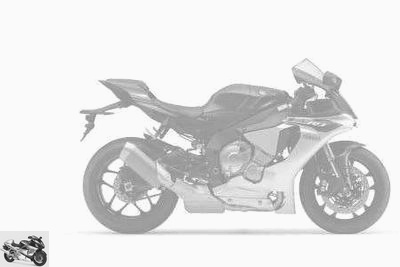
- Transmission
- 6-speed gearbox
- secondary by chain
- Rear axle
- Mono-shock absorber, deb: 120 mm
- 1 disc Ø 220 mm, 1 piston caliper
- Rear wheel:
190/55
– 17
- Motor
- 4 Cylinders
in line
, 4 stroke - Cooling: by water
- Injection Ø nc
- 2 ACT
- 4 valves per cylinder
-
998 cc
(79 x 50.9 mm) -
200
ch
at 13,500 rpm -
11.60 mkg
at 11,500 rpm - Compression: 13: 1
- Crit’air:
Detached pieces
exhaust
motor
fluid
electricity
filtration
braking
chain kit
Competitors
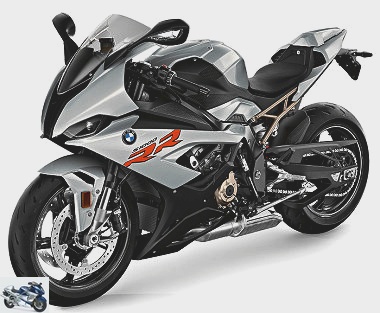
BMW S 1000 RR 2020
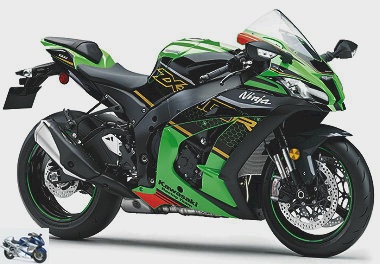
Kawasaki Ninja 1000 ZX-10R KRT Replica 2020
Gallery
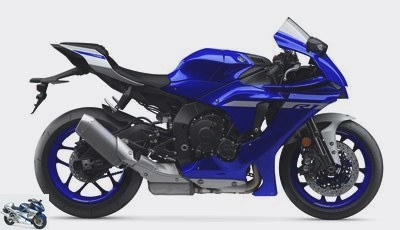
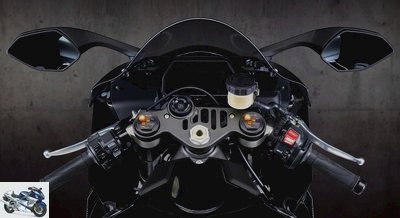
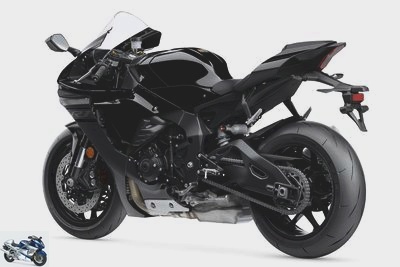
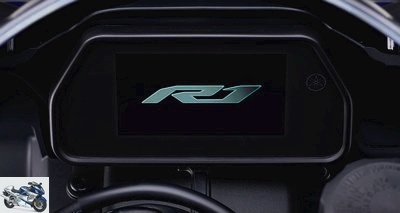
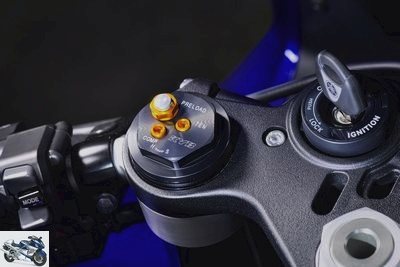
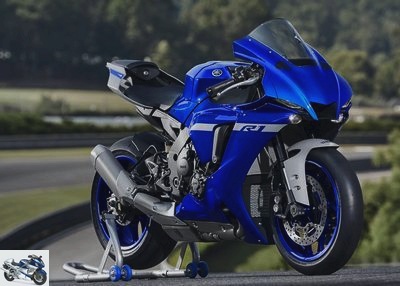
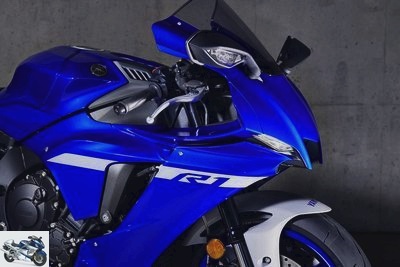
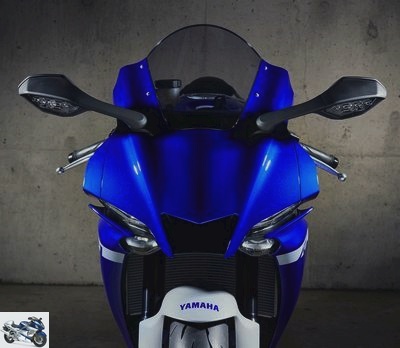
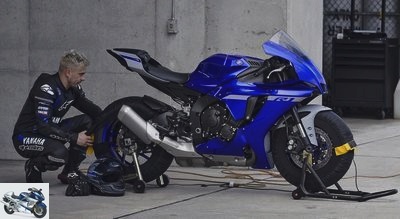
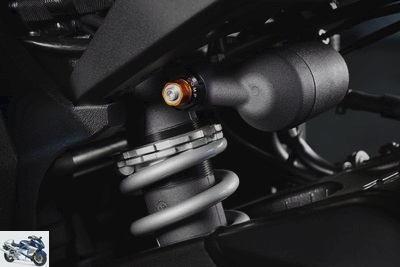
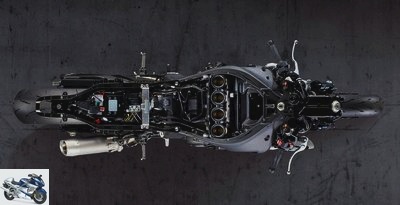
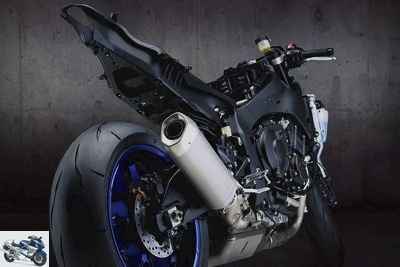
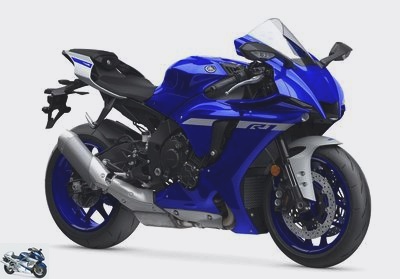
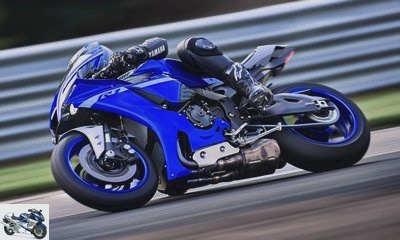
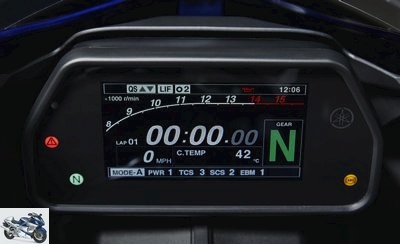
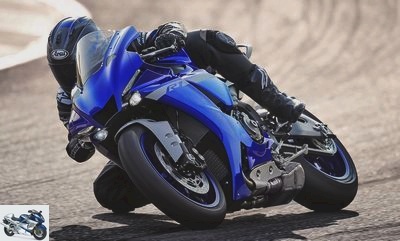
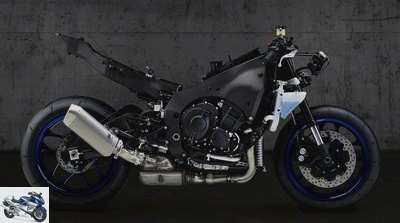
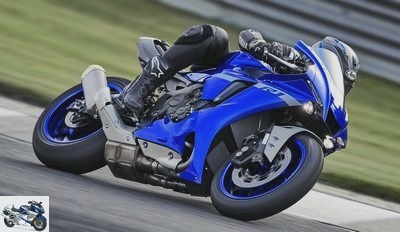
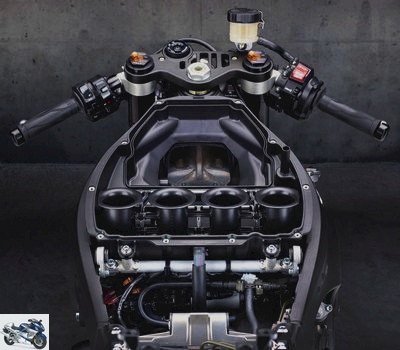
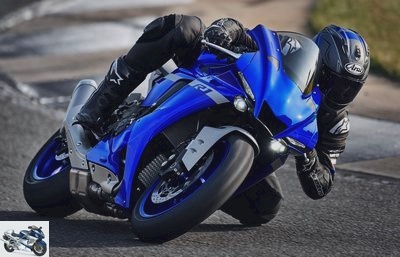
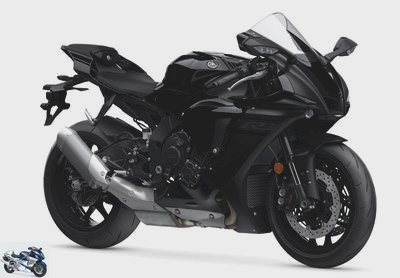
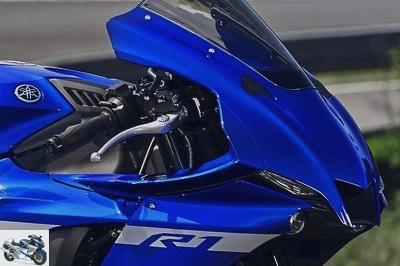
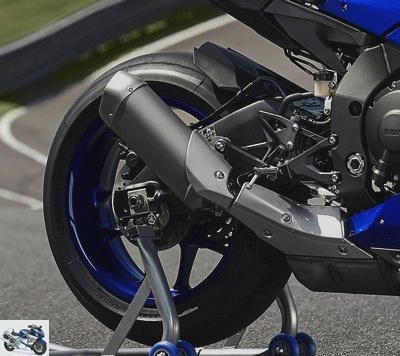
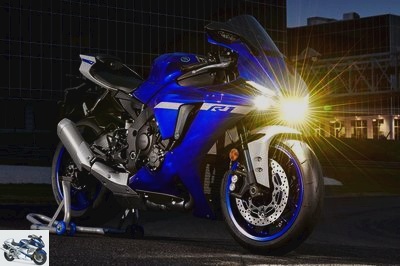
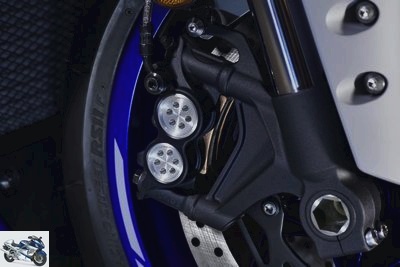
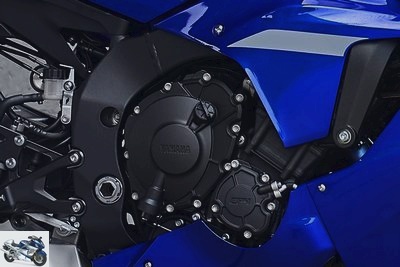
Related articles
-
All ! Everything changed. Except the patronymic; but did it still have to bear the name of R1 as it has evolved?!? Take a good look, from all angles,…
-
All ! Everything changed. Except the patronymic; but did it still have to bear the name of R1 as it has evolved?!? Take a good look, from all angles,…
-
In the crucible of times and trajectories, the R1M does not wait for the years to leave marks on its carbon black skin. Like its sister R1 (without M),…
-
The R1 continues on its way, not at all satisfied with its thirst for performance. The victories in Endurance only reinforce his status as a successful…
-
For 2020, Yamaha has worked hard on its big cross-country machine. The all-new 2020 YZ 450 F is lighter, more powerful and more manoeuvrable. Nothing…
-
Kawasaki Ninja 1000 ZX-10R KRT Replica 2020
The ZX-10R is always looking for power. Last year, its mechanics were entitled to the right care to gain watts. It passed a new stage with a revision of…
-
The R1 continues on its way, not at all satisfied with its thirst for performance. The victories in Endurance only reinforce his status as a successful…
-
Would the potential for upgrading the R1 be unlimited? Vast debate which will be arbitrated this year by a new major evolution of Yamaha’s hypersport….
-
She had changed everything. Except the patronymic; but did it still have to bear the name of R1 as it has evolved?!? Take a good look, from all angles,…
-
Shortly after its appearance, the Yamaha MT-10 had already received its first improvements. The most notable was the appearance of a QSS shifter,…